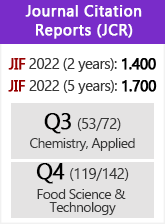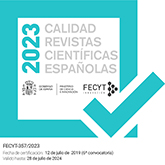Production of high quality castile soap from high rancid olive oil
DOI:
https://doi.org/10.3989/gya.2003.v54.i3.235Keywords:
Castile soap, Chemical properties, Edible olive oil, High rancid olive oil, Physical properties, StorageAbstract
Non-edible olive oil, characterized by high acid and peroxide values as well as deep in color and unpleasant odor, was used to produce a fine castile soap (soap sample nº. 1). Semi-fine virgin olive oil was also used to produce the standard castile soap (soap sample nº. 2). The obtained results illustrated that the unpleasant odor was disappeared in soap nº. 1 compared to the standard soap (weakly like oil). Also, there were remarkable that no high differences were observed in all physical and chemical properties (appearance, smooth surface, erosion from hand-washing, consistency, moisture content, total fatty acids, free alkali and salt content) in the two fresh soap samples. Whilst, the color in soap sample nº. 1 was fuscous green color compared to the standard soap (which was white to pale yellow). Soap samples were stored on a shelf at room temperature for 6 months showed some changes in their chemical properties. On the other hand, physical properties of the above two samples were improved after the storage period (6 months) where their structures became very firm with high lather volume and rates of their erosions from hand-washing were retrenched except, the color in soap sample nº. 1 was not improved which was dark green color.
Therefore, the present study recommend to use non-edible olive oil as unusually fatty material to produce a fine castile soap (high smooth surface, fairly lather and high glossy appearance) as an alternative to edible olive oil (which is very expensive) and also to reduce the cost of castile soap manufacturing.
Downloads
Download data is not yet available.
Downloads
Published
2003-09-30
How to Cite
1.
Girgis AY. Production of high quality castile soap from high rancid olive oil. Grasas aceites [Internet]. 2003Sep.30 [cited 2024Jul.27];54(3):226-33. Available from: https://grasasyaceites.revistas.csic.es/index.php/grasasyaceites/article/view/235
Issue
Section
Research
License
Copyright (c) 2003 Consejo Superior de Investigaciones Científicas (CSIC)

This work is licensed under a Creative Commons Attribution 4.0 International License.
© CSIC. Manuscripts published in both the printed and online versions of this Journal are the property of Consejo Superior de Investigaciones Científicas, and quoting this source is a requirement for any partial or full reproduction.All contents of this electronic edition, except where otherwise noted, are distributed under a “Creative Commons Attribution 4.0 International” (CC BY 4.0) License. You may read here the basic information and the legal text of the license. The indication of the CC BY 4.0 License must be expressly stated in this way when necessary.
Self-archiving in repositories, personal webpages or similar, of any version other than the published by the Editor, is not allowed.
















